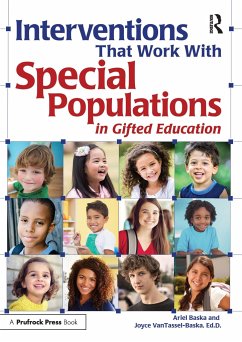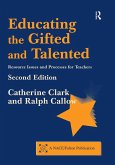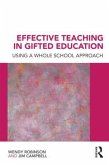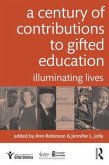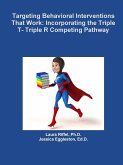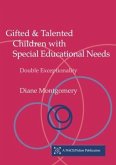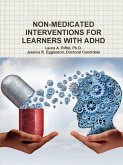Ariel Sloan Baska, Joyce Vantassel-Baska
Interventions That Work with Special Populations in Gifted Education
Schade – dieser Artikel ist leider ausverkauft. Sobald wir wissen, ob und wann der Artikel wieder verfügbar ist, informieren wir Sie an dieser Stelle.
Ariel Sloan Baska, Joyce Vantassel-Baska
Interventions That Work with Special Populations in Gifted Education
- Broschiertes Buch
- Merkliste
- Auf die Merkliste
- Bewerten Bewerten
- Teilen
- Produkt teilen
- Produkterinnerung
- Produkterinnerung
This text is for regular classroom teachers who work with special needs learners in their classrooms, and the specialists and administrators who support these populations.
Andere Kunden interessierten sich auch für
![Educating the Gifted and Talented Educating the Gifted and Talented]() Catherine ClarkEducating the Gifted and Talented55,99 €
Catherine ClarkEducating the Gifted and Talented55,99 €![Effective Teaching in Gifted Education Effective Teaching in Gifted Education]() Wendy RobinsonEffective Teaching in Gifted Education66,99 €
Wendy RobinsonEffective Teaching in Gifted Education66,99 €![A Century of Contributions to Gifted Education A Century of Contributions to Gifted Education]() A Century of Contributions to Gifted Education76,99 €
A Century of Contributions to Gifted Education76,99 €![Targeting Behavioral Interventions That Work Targeting Behavioral Interventions That Work]() Laura RiffelTargeting Behavioral Interventions That Work22,99 €
Laura RiffelTargeting Behavioral Interventions That Work22,99 €![Gifted and Talented Children with Special Educational Needs Gifted and Talented Children with Special Educational Needs]() Diane MontgomeryGifted and Talented Children with Special Educational Needs49,99 €
Diane MontgomeryGifted and Talented Children with Special Educational Needs49,99 €![NON-MEDICATED INTERVENTIONS FOR LEARNERS WITH ADHD NON-MEDICATED INTERVENTIONS FOR LEARNERS WITH ADHD]() Laura A. RiffelNON-MEDICATED INTERVENTIONS FOR LEARNERS WITH ADHD21,99 €
Laura A. RiffelNON-MEDICATED INTERVENTIONS FOR LEARNERS WITH ADHD21,99 €
This text is for regular classroom teachers who work with special needs learners in their classrooms, and the specialists and administrators who support these populations.
Produktdetails
- Produktdetails
- Verlag: Taylor & Francis
- Seitenzahl: 184
- Erscheinungstermin: 1. Juli 2018
- Englisch
- Abmessung: 254mm x 179mm x 15mm
- Gewicht: 337g
- ISBN-13: 9781618217097
- ISBN-10: 1618217097
- Artikelnr.: 47626357
- Herstellerkennzeichnung
- Libri GmbH
- Europaallee 1
- 36244 Bad Hersfeld
- gpsr@libri.de
- Verlag: Taylor & Francis
- Seitenzahl: 184
- Erscheinungstermin: 1. Juli 2018
- Englisch
- Abmessung: 254mm x 179mm x 15mm
- Gewicht: 337g
- ISBN-13: 9781618217097
- ISBN-10: 1618217097
- Artikelnr.: 47626357
- Herstellerkennzeichnung
- Libri GmbH
- Europaallee 1
- 36244 Bad Hersfeld
- gpsr@libri.de
Ariel Baska teaches all levels of Latin in Fairfax County Public Schools. She received her Bachelor's degree in Classics from William & Mary. She received her Master's degree in Curriculum Studies with an emphasis in Gifted Education at George Mason University. Joyce VanTassel-Baska, Ed.D., is the Jody and Layton Smith Professor Emerita of Education and former Executive Director of the Center for Gifted Education at William & Mary in Virginia, where she developed a graduate program and a research and development center in gifted education. She also initiated and directed the Center for Talent Development at Northwestern University.
Preface Introduction Part I: Who Are Gifted Learners With Special Needs?
Defining Special Populations of Gifted Students Case Studies of Successful
Students From Special Populations Max Laura Ryan Andrea Mitch Carla Barry
Ralph Rachel Charles Commonalities Across the Profiles Talent Trajectories
of Special Populations Issues and Problems for Special Populations in
Schools and Gifted Programs Conclusion Part II: What Interventions Work
With Special Populations? School-Based Interventions Acceleration in a
Strength Area Personal Relationships With Teachers and Other Personnel
Mentorships and Internships Career Exploration Classroom-Based
Interventions Problem-Based Learning The Literature Web Higher Level
Questioning/Thinking Creative Expression The Arts as a Cognitive Tool for
Learning Affective Curriculum Needs Conclusion Part III: Support Structures
for Intervention Services Developing Support Structures for Special
Populations Characteristics and Practices of Successful Teachers Structures
for Special Populations in Classrooms and Schools Parental Roles and
Responsibilities Implications for Gifted Education, ELL Programs, and
Special Education Conclusion Final Thoughts Resources References Appendix
A: Literature Web Appendix B: Independent Learning Contract Appendix C:
Quarterly Survey With Responses About the Authors.
Defining Special Populations of Gifted Students Case Studies of Successful
Students From Special Populations Max Laura Ryan Andrea Mitch Carla Barry
Ralph Rachel Charles Commonalities Across the Profiles Talent Trajectories
of Special Populations Issues and Problems for Special Populations in
Schools and Gifted Programs Conclusion Part II: What Interventions Work
With Special Populations? School-Based Interventions Acceleration in a
Strength Area Personal Relationships With Teachers and Other Personnel
Mentorships and Internships Career Exploration Classroom-Based
Interventions Problem-Based Learning The Literature Web Higher Level
Questioning/Thinking Creative Expression The Arts as a Cognitive Tool for
Learning Affective Curriculum Needs Conclusion Part III: Support Structures
for Intervention Services Developing Support Structures for Special
Populations Characteristics and Practices of Successful Teachers Structures
for Special Populations in Classrooms and Schools Parental Roles and
Responsibilities Implications for Gifted Education, ELL Programs, and
Special Education Conclusion Final Thoughts Resources References Appendix
A: Literature Web Appendix B: Independent Learning Contract Appendix C:
Quarterly Survey With Responses About the Authors.
Preface Introduction Part I: Who Are Gifted Learners With Special Needs?
Defining Special Populations of Gifted Students Case Studies of Successful
Students From Special Populations Max Laura Ryan Andrea Mitch Carla Barry
Ralph Rachel Charles Commonalities Across the Profiles Talent Trajectories
of Special Populations Issues and Problems for Special Populations in
Schools and Gifted Programs Conclusion Part II: What Interventions Work
With Special Populations? School-Based Interventions Acceleration in a
Strength Area Personal Relationships With Teachers and Other Personnel
Mentorships and Internships Career Exploration Classroom-Based
Interventions Problem-Based Learning The Literature Web Higher Level
Questioning/Thinking Creative Expression The Arts as a Cognitive Tool for
Learning Affective Curriculum Needs Conclusion Part III: Support Structures
for Intervention Services Developing Support Structures for Special
Populations Characteristics and Practices of Successful Teachers Structures
for Special Populations in Classrooms and Schools Parental Roles and
Responsibilities Implications for Gifted Education, ELL Programs, and
Special Education Conclusion Final Thoughts Resources References Appendix
A: Literature Web Appendix B: Independent Learning Contract Appendix C:
Quarterly Survey With Responses About the Authors.
Defining Special Populations of Gifted Students Case Studies of Successful
Students From Special Populations Max Laura Ryan Andrea Mitch Carla Barry
Ralph Rachel Charles Commonalities Across the Profiles Talent Trajectories
of Special Populations Issues and Problems for Special Populations in
Schools and Gifted Programs Conclusion Part II: What Interventions Work
With Special Populations? School-Based Interventions Acceleration in a
Strength Area Personal Relationships With Teachers and Other Personnel
Mentorships and Internships Career Exploration Classroom-Based
Interventions Problem-Based Learning The Literature Web Higher Level
Questioning/Thinking Creative Expression The Arts as a Cognitive Tool for
Learning Affective Curriculum Needs Conclusion Part III: Support Structures
for Intervention Services Developing Support Structures for Special
Populations Characteristics and Practices of Successful Teachers Structures
for Special Populations in Classrooms and Schools Parental Roles and
Responsibilities Implications for Gifted Education, ELL Programs, and
Special Education Conclusion Final Thoughts Resources References Appendix
A: Literature Web Appendix B: Independent Learning Contract Appendix C:
Quarterly Survey With Responses About the Authors.

